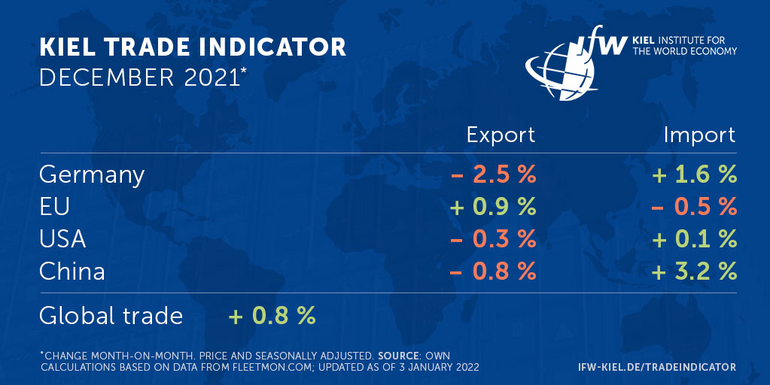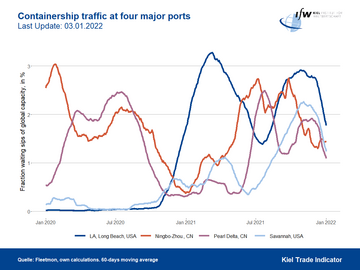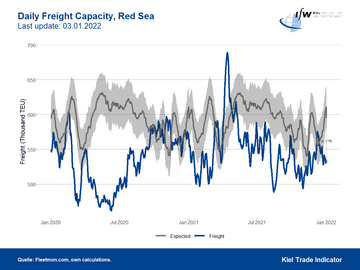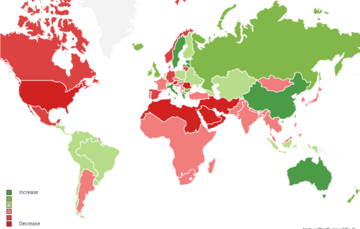News
Kiel Trade Indicator 12/2021: World trade unimpressed by Omicron so far

For Germany, the indicator for December 2021 signals a slightly negative export trend at - 2.5 percent, while imports remain on a slight upward trajectory at 1.6 percent. For the entire EU, the signs are reversed (exports +0.9 %, imports -0.5 %), but the values are within a range that indicates stagnation.
After negative signs for China's trade in previous months, the Kiel Trade Indicator for December shows a sideways movement. When interpreting the figures from China, the normally high fluctuations in monthly values there must be taken into account.
According to the Kiel Trade Indicator, changes in US imports and exports are close to zero. However, there are signs of a positive development at the American ports: After the Christmas shopping season, the pressure on the ports of Los Angeles and Savannah appears to be easing slightly, and ship congestion is reducing there. However, with about 11 percent of shipped goods still trapped in stalled vessels, congestion only seems to be shifting to other ports and areas.

"As previously expected, there are no clear signs of any catch-up effects in world trade around the turn of the year. We will probably have to wait at least until after the Chinese New Year for a normalization of sea freight traffic. Particular attention must be paid to Chinese ports. Should China again react drastically with port closures to new Covid19 cases, this could again put supply chains under stress," said Vincent Stamer, Head of Kiel Trade Indicator, on the occasion of the latest data update.

The volume of cargo in the Red Sea, an important indicator for European-Asian trade, approached its expected level for the month in December, but is currently around 11 percent below it again.
The next Kiel Trade Indicator updates will be on January 20 (without media information) and February 7 (with media information for January 2022 trade data).
For more information on the Kiel Trade Indicator and forecasts for 75 countries, visit www.ifw-kiel.de/tradeindicator.

About the Kiel Trade Indicator
The Kiel Trade Indicator estimates trade flows (imports and exports) for 75 countries worldwide, the EU and world trade as a whole. It is based on the evaluation of ship movement data in real time. An algorithm programmed at the Kiel Institute uses artificial intelligence to analyze the data and translates the ship movements into real, seasonally adjusted growth figures compared with the previous month.
We update the data twice a month. Around the 20th (without press release) for the current and the following month and around the 5th (with press release) for the previous and the current month.
Arriving and departing ships are recorded for 500 ports worldwide. In addition, ship movements in 100 maritime regions are analyzed and the effective utilization of container ships is derived from draught information. Country-port correlations can be used to generate forecasts, even for countries without their own deep-sea ports.
Compared to previous leading trade indicators, the Kiel Trade Indicator is available much earlier, is much more comprehensive, relies on a uniquely large database using big data, and has a low statistical error by comparison. The algorithm of the Kiel Trade Indicator uses machine learning, so that the quality of the forecast continues to improve over time.